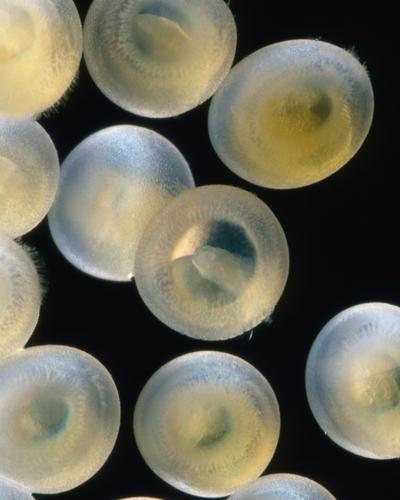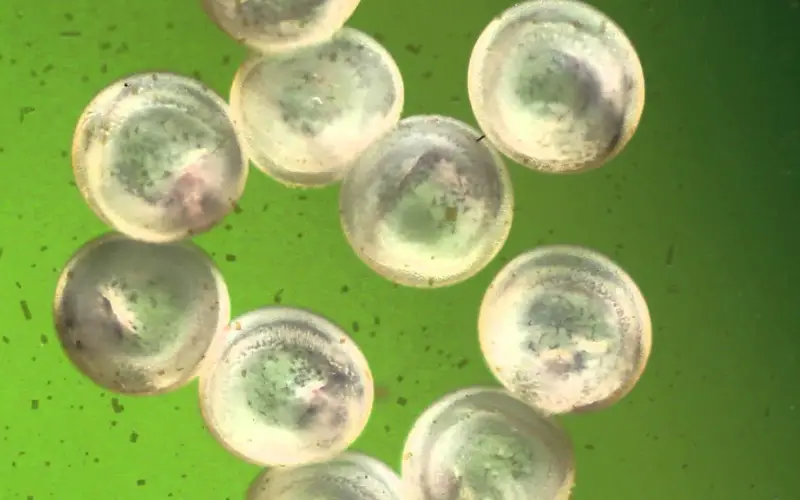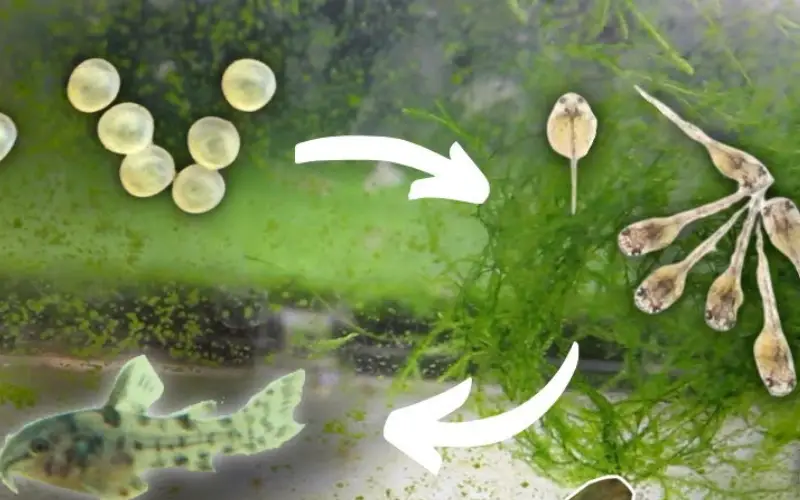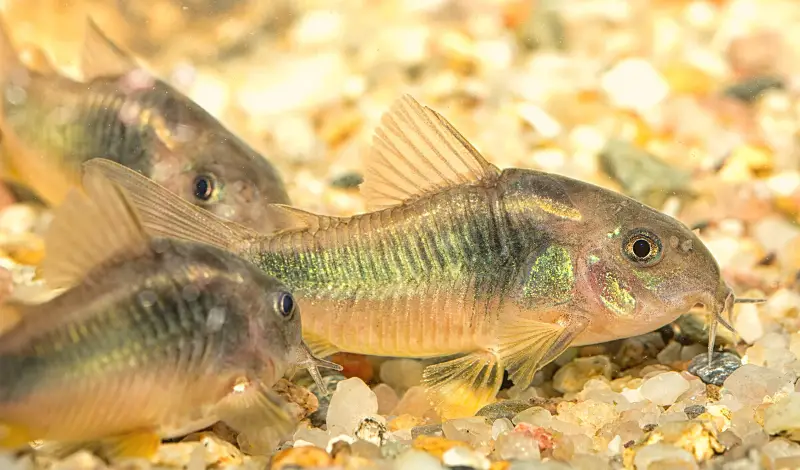Cory Catfish Egg Development: Raising Cory catfish can be a fun and rewarding experience, but it’s essential to know how to care for them properly if you want them to reach their full potential.
Cory catfish are some of the most popular freshwater fish species among aquarists.
This is mainly due to their peaceful demeanor, attractive appearance, and hardiness against standard water parameters and conditions, Breeding Cory catfish habits are unique among aquatic species.

As dedicated parents, they lay their eggs, and the adults guard the nest to ensure that young fry receives proper care until they become independent.
It is truly inspiring how these fish go above and beyond for their offspring!
Many people don’t realize that Cory fish eggs need special care if you want to hatch Cory catfish successfully.
And even if you do manage to get them to hatch, there’s still a lot of work involved in raising the fry until they’re ready to be released into your breeding tank.
We’ll also discuss how long does it take for corydora eggs to hatch, AND Cory’s parental behavior and the best environment for successful spawning. So sit back and enjoy learning about one of the aquarium hobby’s most remarkable members!
Table of Contents
ToggleWhat Do Cory Catfish Eggs Look Like?
Corydoras egg colors can be very distinct and are accompanied in the eggshell by evident traces. 1-2mm eggs are deposited between 10-20 in small groups. Within a few days of fertilization, eggs turn brown and black, and a tiny black spot appears.

The female easily distinguishes Cory fish eggs from others, usually sticking them in tiny groups of between 10 and 20 eggs in the flat areas around them.
Eggs usually lay against glass, filters, plants, and wood. If you find eggs that satisfy all these criteria, your Cory Catfish will get some attention.
Overview of Cory Catfish Egg Development and Fertilization
The process of corydoras egg development starts with the female laying eggs in clusters on various surfaces, usually on plants or glass.
After the Corydoras eggs have been laid, it’s crucial to provide appropriate water conditions to begin to develop correctly.
Corys are one of the few species of fish which practice external fertilization, meaning that the eggs require a male Cory to pass over them to be fertilized.
A male Cory will swim over the egg clusters, releasing sperm onto them and distributing it evenly. The process is known as “treading” and can take up to 30 minutes for a single cluster of corydoras eggs.
How long does it take for corydora eggs to hatch? Once the eggs have been fertilized, they will begin to develop and can take five to ten days to hatch.
Caring for Cory Catfish Eggs
Once your Cory cat eggs have been laid, you must provide the proper care to ensure their successful development.
First, it’s essential to make sure that the water temperature stays between 76-82 degrees Fahrenheit (25-28 Celsius). This will ensure that the fertilized eggs can develop properly.
It’s also a good idea to add some aeration system, “air stone or air pump,” to increase oxygen levels. This will create a more stable environment for your catfish eggs in water tank and help keep their development on track.
Finally, ensure you do not disturb the egg clusters while they develop. This could cause them to die prematurely and hinder their progress.
Raising Corydoras Catfish Fry
Once your Cory fish eggs have hatched, you’ll be left with small fries that must be looked after.
It would help if you started by ensuring the water was at the same temperature as when the eggs were laid. This will ensure that the fry continues to develop correctly and remain healthy.
It’s also important to feed your Corydoras fry various types of food. Baby brine shrimp, daphnia, and crushed flake food are all good choices for baby fish. You’ll want to ensure that the food you provide is small enough for them to swallow easily.
Finally, providing plenty of hiding places in your tank for the fry is essential. This will give them a safe place.
Understanding the Hatching Process of Cory Catfish Eggs
Hatching is the process of Corydora catfish eggs emerging from their shells and becoming fry. This process can take five to ten days, depending on the environmental conditions.
The hatching begins with the embryo developing and absorbing nutrients from the egg’s yolk sac. As it grows, it will eventually become large enough that it can begin to break through the eggshell.
Once the fry is ready, it will break out of its shell and swim away from the cluster. This process can take anywhere from a few minutes to a few hours. Once all the fertilized eggs hatched, you’ll be left with dozens of tiny catfish fry swimming around your tank.
Caring for newly hatched Cory catfish fry is integral to successfully raising them to adulthood. Providing the right water conditions, food, and hiding places will help ensure your fry grows healthy and strong.
With proper care, these adorable little fish can make great additions to any aquarist’s community tank!
Cory Catfish eggs Hatching time
It typically takes between 3 – 5 days of hatching. In some rare cases, egg formation can be delayed by 7 days. The hatching time can depend on the type and water conditions like temperature.
When egg-laying is imminent, the Corydra’s tails fry up, and its tail is tiny. Do not be concerned when you notice swans or eggs with a tail. It is a natural process that happens when the egg formation process begins.
How to Tell If Cory Eggs Are Fertile?
A common question among aquarists is how to tell if Cory’s eggs are fertile. Fortunately, this is relatively easy to determine with little observation and patience.
First, look at the egg clusters and see if they are transparent or opaque. Clear eggs are usually fertile; opaque eggs are usually not.
Second, observe the adult Cory Catfish parents. If they are actively tending to the eggs and defending the area, then it’s likely that the eggs are fertile.
Finally, if you want to be sure, gently touch one of the eggs with a fingertip to see if it is still alive. A dead egg will be soft and easily collapse under pressure, while a living egg will be firm and resilient.
Once you’ve determined that the eggs are fertile, it’s time to provide a stable environment for them to hatch. Make sure the water temperature is kept at a constant level, and do
By following these steps, you can be sure that your Cory cat eggs are fertile and ready to hatch.
Do Cory Catfish Lay Unfertilized Eggs?
Yes, Cory Catfish can lay unfertilized eggs. This usually happens when the fish are not in breeding conditions or the water conditions are not optimal for fertilization.
Female Cory catfish can lay unfertilized eggs out of instinct or due to stressful conditions. Even when the tank only contains female fish, they will still create these non-viable eggs due to their instincts!

To prevent your Cory catfish from laying unfertilized eggs, ensure they are in the proper breeding conditions and that the tank water is well cared for.
In addition, provide plenty of hiding places in your community tank for the fry. This will give them a safe place to hide from predators and ensure they get enough food to grow.
How Do Cory Catfish Eggs Get Fertilized?
The male fish usually fertilize Cory catfish eggs. As they prepare to lay eggs, female and male Corys perform a courtship dance to entice the other fish and get them into breeding conditions.
Once the female Cory catfish lays eggs, the male will release his milt (sperm) over the eggs. This process, called “miltation,” helps ensure the eggs are fertilized.

It is important to note that Cory Catfish can also be artificially inseminated, but a professional fish breeder or qualified aquarist should only do this.
Once the Cory catfish eggs Fertilized, it is up to the aquarist to provide the necessary care and conditions for fertilized eggs to hatch. Temperature, water quality, and food are all Raising Fry.
How Often Do Cory Catfish Lay Eggs?
Cory catfish (Corydoras spp.) typically lay eggs once every two to three weeks for a brief period. Depending on the species, the female will usually lay between 10 and 50 eggs during this window.
When females lay eggs, the catfish eggs in water are adhesive and adhere to flat surfaces like rocks and artificial decorations. The parents should be removed from the tank after spawning to prevent them from eating their eggs.
How Many Eggs Do Cory Catfish Lay?
Cory Catfish are prolific breeders; each female can lay up to 50 eggs in a single spawning session. The number of eggs the fish will lay depends on the female’s size and age, among other factors.
After spawning, the male will guard their precious cargo until they hatch in 2-4 days depending on water temperature.
In optimal conditions (between 74-81 degrees Fahrenheit), up to 95% of eggs can survive as long as there is plenty of oxygen to feed off, with ample space for swimming when fully grown.
What to do with Cory Catfish Eggs?
You have probably observed egg-laying or seen breeder behavior. Woohoo! The best part can start: with laying eggs. Remove eggs from the glass and structures to guarantee a reasonable hatching rate. Put eggs in separate containers. Change the water once daily so Corydoras fry hatch.
When the eggs are ready to hatch, it’s time to prepare for raising fry. Be sure to provide plenty of food and a well-oxygenated tank. Lower the water levels and ensure that the water temperature is kept at a constant level, and do not forget to provide plenty of hiding spots for the fry.
By providing the proper care and attention, Corydoras eggs should hatch within 10-15 days, and when they do, you’ll have your school of fry!
Enjoy the rewarding experience and enjoy watching your fish grow up. Keep an eye on them and provide necessary care as they grow. Good luck!
Preparing the Tank before Cory Catfish Eggs Hatch
So you’ve just discovered that your Cory Catfish have laid eggs and are unsure what to do!
Don’t worry; we’ve all been there. This short video tutorial will teach you how to prepare the tank before the sticky catfish eggs in water hatch correctly.
First, you need to ensure the water is clean and stable. Check the ammonia levels and ensure they are safe (0.5 ppm or less). You’ll also want to ensure the temperature is between 74-81 degrees Fahrenheit and that there is plenty of oxygen in the water.
Next, ensure plenty of space for the fry once they hatch. Lower the water level in the tank, as this will make it easier for the fry to feed and swim.
You should also add some live plants or dark decorations to the tank. This will help create more hiding spots for the fry and give them a place to hide when they feel threatened.
Finally, provide plenty of food for the baby fish, such as tiny flakes, baby brine shrimp, or other appropriate foods.
By following these simple steps, you can ensure that your Cory cats eggs hatch sooner successfully and that the new fry has a safe and comfortable home.
Tips on Caring for and Raising Cory Catfish Fry
Congratulations! You’ve successfully hatched Corydoras Fry! Now it’s time to learn how to properly care for and raise them.
- First, you’ll need to provide plenty of food for them. Tiny flakes or baby brine shrimp would be ideal. You should also feed them multiple times a day in small amounts and avoid overfeeding.
- Second, you need to make sure the water is clean and stable. Check the ammonia levels and make sure they are safe (0.5 ppm or less). You’ll also want to ensure the temperature is between 74-81 degrees Fahrenheit and that there is plenty of oxygen in the water.
- Third, you should provide plenty of hiding places for the fry in the tank. Live plants or dark decorations are perfect for this. This will give them a place to hide when they feel threatened and make them feel secure.
- Finally, you should monitor the fry closely and take steps to prevent overcrowding with regular tank maintenance.
Foods to Feed Newly Hatched Cory Catfish Fry
Newly hatched Cory Catfish Fry should be fed live and frozen foods; avoid giving them dry flakes or pellets. Live foods, such as daphnia, micro worms, and newly hatched brine shrimp, are best for fry to feed on.
You can also give the fry finely crushed freeze-dried bloodworms and tubifex worms, as well as chopped earthworms that have been chopped into small pieces. The frequency at which you feed your Cory fish fry will depend on their size.
Start with small amounts once a day, but if they finish before 15 minutes, then increase the amount gradually until they leave uneaten food behind after 15 minutes of eating – this is when you know you’re feeding them enough!
Additionally, while Corydoras eat multiple times daily, try not to exceed 3 times a day to prevent overfeeding.
Conclusion
Overall, Corys fish eggs have a long and vital journey as they incubate and begin to hatch. With proper care and attention from an aquarist during this time, the chances of success are improved. Regular water temperature checks, siphoning off debris or hatched eggs on the bottom of the tank, and monitoring oxygen levels can help ensure the health of the fry once hatched.
Considering how long do Cory eggs take to hatch, patience is vital to having well-developed fry ready for life in an aquarium. Feeding them foods like brine shrimp can be beneficial to their growth too. Overall, Cory Catfish make beautiful additions to any freshwater tank and are relatively easy breeding Cory once conditions are appropriate. Here’s hoping your Cory Catfish fry enjoy a happy and successful life in their new home!
You might also like
- How Often Do Cory Catfish Lay Eggs – What You (Should Know)
- Do Cory Catfish Eat Their Eggs? (5 Essential Tips & Tricks)
- Corydoras catfish eggs 101: A Comprehensive Guide (for Beginners)
- How Often Do Cory Catfish Breed? Beginners Kickstart (Guide)
- Caring for Cory Catfish: Types, Diet, Lifespan & Tankmates (FAQ)




